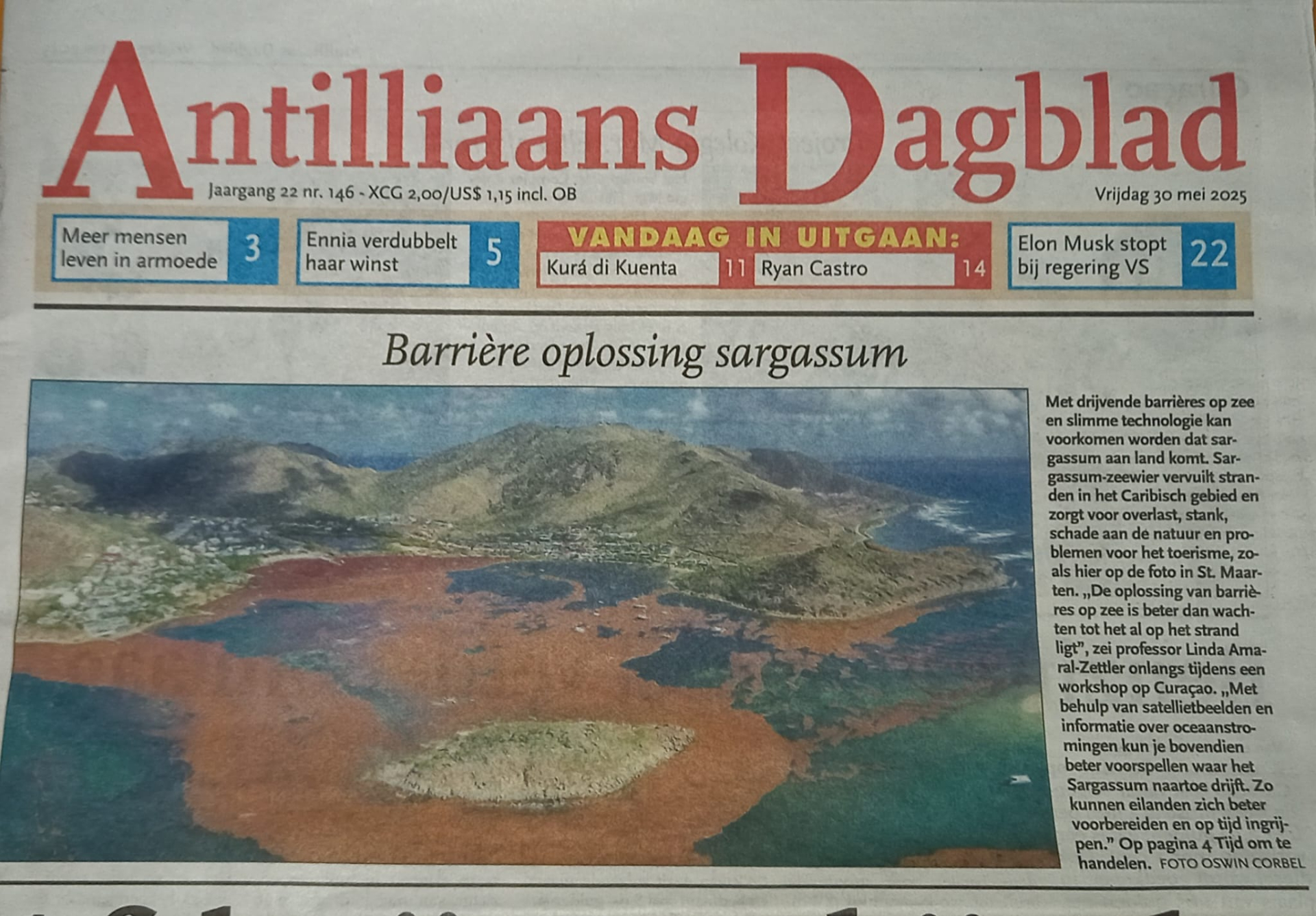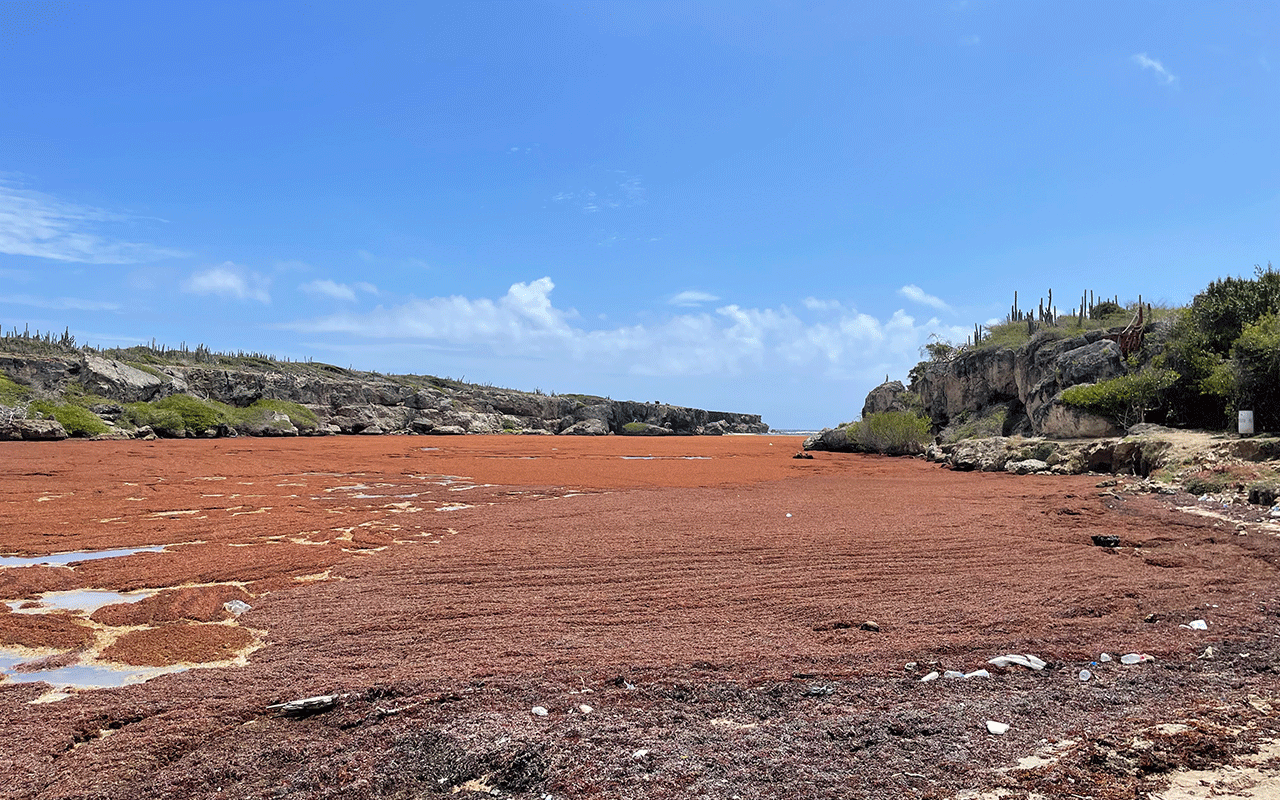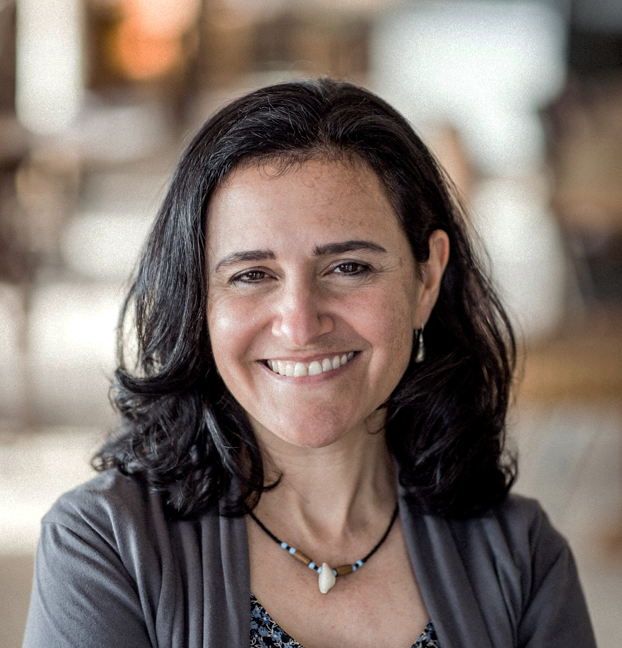From science to action: Workshop marks turning point in regional Sargassum response
- Dutch translation below -
The workshop took place at CARMABI in Curaçao, on 8 May, and was organized by the CARMABI Foundation (Caribbean Research and Management of Biodiversity) in collaboration with NIOZ (Royal Netherlands Institute for Sea Research) and the University of Amsterdam (UvA). Representatives from science, government, NGOs and the private sector came together to set a joint course for tackling the ongoing Sargassum challenges in the Caribbean.
“Now it is time to take what I have learned”
The workshop was also the end of a four-week intensive course on the topic of sargassum, bringing together the next generation of scientists with local stakeholders and international experts to translate their findings into actionable solutions. Scientific insights from countries such as Curaçao, Mexico, Barbados, Canada, the Netherlands and the US were shared, and there is a broad consensus that the time for analysis alone is over – it is time for a coordinated and responsible approach. “Now it is time to take what I have learned and build on it to help Jamaica and the wider Caribbean in whatever way possible” echoes Matthew-Pierre Rogers, a Jamaican-native and student participant in the workshop and course.
Participants underlined that effective control of Sargassum should focus on two main areas: the open ocean and the coastal regions. Early interception of the weeds in the open ocean prevents coastal impact. And efficient removal from the shores minimizes damage to ecosystems and infrastructure. “Clearing Sargassum from coastlines after it has stranded is not the best option, but you can still prevent it from stranding even when it is closer to the coast, via booms. Several countries are using this approach,” says Prof. dr. Linda Amaral-Zettler, UvA course director and NIOZ scientist.
Modelling techniques, including satellite detection, ocean current analysis and real-time data, will play a key role in determining where, when, and how Sargassum can be captured. This knowledge is essential to operate efficiently and limit ecosystem damage, including protecting iconic species like the sea turtles that seek Sargassum as a protective haven in open waters.

Cross-border cooperation is crucial
The need for international agreements was emphasized repeatedly. Cross-border cooperation is crucial for a successful approach, with an eye for local and international legal frameworks and ecological stipulations. It is necessary to support small-scale initiatives and scale them up in phases based on experience and evaluation.
Finally, it was acknowledged that the impact of Sargassum differs greatly from country to country. From small islands in the Caribbean to coastal countries in the Americas, each region faces unique social, environmental and economic challenges. A sustainable and just solution can only be achieved through regional cooperation and knowledge sharing.
If translated into concrete action, these findings could help prevent the worst impacts of Sargassum, protect livelihoods and nature, and strengthen regional cooperation. “We hope that this workshop will be a kick starter for that translation to happen,” concludes Amaral-Zettler.
About the organizers and participants
This workshop was co-supported by the National Decade Committee of the Netherlands in the context of the United Nations Decade of Ocean Science for Sustainable Development and funding from the NWO-Caribbean Program (NWOCA.1).
CARMABI serves as a bridge between science and local solutions by translating complex research into practical strategies for coastal communities, working closely with local stakeholders, fishermen, and policymakers to implement nature-based solutions that protect both livelihoods and ecosystems.
The University of Amsterdam’s “Seaweeds on Shore and at Sea” master’s course included a 10-day sea component on the Dutch research vessel R/V Pelagia (PE542 expedition) followed by two weeks of intensive course and lab work on shore at CARMABI. The land-based program included 4 faculties and 10 students from 7 countries, including 4 from Sargassum-impacted countries, who presented their science and marine policy results at the workshop.

Van wetenschap naar actie: tijd voor regionale aanpak van Sargassum
Wilemstad, 30 mei 2025 – Het is tijd om actie te ondernemen tegen de problemen met sargassum-aanspoelingen in het Caribisch gebied, want er is voldoende kennis om dat effectief aan te pakken. Dat concludeerden onderzoekers, overheidsfunctionarissen, ngo’s en de private sector tijdens een Internationale Sargassum Stakeholder Workshop.
De deelnemers van de workshop adviseren een tweeledige aanpak. Ten eerste sargassum op zee verzamelen voordat het aanspoelt, om te voorkomen dat het de kust bereikt. Ten tweede, als het toch aanspoelt, kan efficiënte verwijdering de schade aan ecosystemen en infrastructuur minimaliseren. Er was brede overeenstemming dat de tijd van alleen analyseren voorbij is – het is tijd voor een gecoördineerde en verantwoorde aanpak.
De workshop vond 8 mei plaats op Curaçao, en werd georganiseerd door de Stichting CARMABI (Caribbean Research and Management of Biodiversity), het NIOZ (Koninklijk Nederlands Instituut voor Onderzoek der Zee) en de Universiteit van Amsterdam. Wetenschappelijke inzichten uit landen als Curaçao, Mexico, Barbados, Canada, Nederland en de VS werden gedeeld. Doel was om samen om een koers te bepalen voor de aanhoudende sargassum-problemen in het Caribisch gebied.
"Nu is het tijd om te gaan toepassen wat ik heb geleerd”
De workshop was ook de afsluiting van een vier weken durende cursus voor studenten over sargassum. “Nu is het tijd om te gaan toepassen wat ik heb geleerd om Jamaica en het Caribisch gebied te helpen,” zegt de Jamaicaanse student Matthew-Pierre Rogers.
“Sargassum verwijderen van de kust nadat het is aangespoeld is niet de beste optie”, zegt prof. dr. Linda Amaral-Zettler, cursusleider van de UvA en NIOZ-onderzoeker. “Je kunt met drijvende barrières het aanspoelen voorkomen, zelfs wanneer het dichter bij de kust komt. Verschillende landen passen deze methode al toe.”
Modelleringstechnieken, waaronder satellietdetectie, analyse van oceaanstromingen en realtime gegevens, spelen een sleutelrol bij het bepalen waar, wanneer en hoe sargassum onderschept kan worden. Zo is schade aan ecosystemen te beperken. Iconische soorten zoals zeeschildpadden, die sargassum als een veilige schuilplaats in open water gebruiken, kunnen dan beschermd worden.
Internationaal samenwerken is noodzakelijk
Internationale afspraken zijn noodzakelijk, met oog voor lokale en internationale wet- en regelgeving en ecologische randvoorwaarden. De impact van sargassum verschilt sterk per land. Van kleine eilanden in het Caribisch gebied tot kustlanden in de Amerika’s: elke regio staat voor unieke sociale, ecologische en economische uitdagingen. Een duurzame en rechtvaardige oplossing is alleen bereikbaar door regionale samenwerking en kennisdeling. Kleinschalige initiatieven hebben ondersteuning nodig; als ze goed blijken te werken kunnen ze worden opgeschaald. ![]()
Over de organisatoren en deelnemers
Deze workshop werd mede ondersteund door het Nationaal Decade Comité van Nederland in het kader van het VN-decennium voor oceaanwetenschap voor duurzame ontwikkeling en met financiering vanuit het NWO-Caribisch programma (NWOCA.1).
Stichting Caribbean Research and Management of Biodiversity (CARMABI) is sinds 1955 actief op Curaçao. De stichting vertaalt marien-biologisch onderzoek naar concrete oplossingen voor kustgemeenschappen, in samenwerking met bijvoorbeeld vissers en beleidsmakers.
De mastercursus Zeewier op de kust en op Zee van de Universiteit van Amsterdam omvatte een tiendaags zeeprogramma aan boord van het Nederlandse onderzoeksschip R/V Pelagia (PE542-expeditie), gevolgd door twee weken cursus- en laboratoriumwerkzaamheden aan wal bij CARMABI. Tien studenten uit zeven landen namen deel, waaronder vier uit sargassum-getroffen landen.

